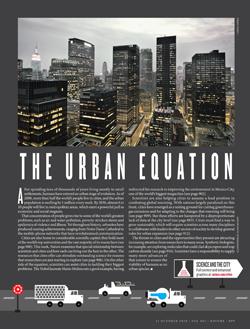Published online 20 October 2010 | Nature 467, 899 (2010) | doi:10.1038/467899a
News Feature
Cities: The urban equation
With the majority of the human population now living in cities,Nature takes a look at the implications for scientists.
After spending tens of thousands of years living mostly in small settlements, humans have entered an urban stage of evolution. As of 2008, more than half the world's people live in cities, and the urban population is swelling by 1 million every week. By 2030, almost 6 in 10 people will live in metropolitan areas, which exert a powerful pull as economic and social magnets.
That concentration of people gives rise to some of the world's greatest problems, such as air and water pollution, poverty-stricken slums and epidemics of violence and illness. Yet throughout history, urbanites have produced soaring achievements, ranging from Notre Dame Cathedral to the mobile-phone networks that have revolutionized communication.
Cities are also home to considerable scientific capital; they hold most of the world's top universities and the vast majority of its researchers (see page 900). This week, Nature examines that special relationship between scientists and cities and how each can bring out the best in the other. The resources that cities offer can stimulate outstanding science for reasons that researchers are just starting to explore (see page 906). On the other side of the equation, scientists can assist cities in tackling their biggest problems. The Nobel laureate Mario Molina sets a good example, having redirected his research to improving the environment in Mexico City, one of the world's biggest megacities (see page 902)./.../


No comments:
Post a Comment